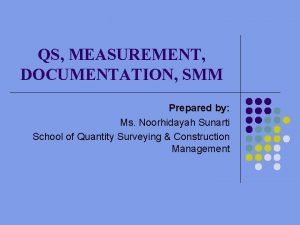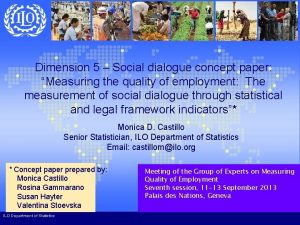Dimension 5 Social dialogue concept paper Measuring the










- Slides: 10

Dimension 5 – Social dialogue concept paper: “Measuring the quality of employment: The measurement of social dialogue through statistical and legal framework indicators”* Monica D. Castillo Senior Statistician, ILO Department of Statistics Email: castillom@ilo. org * Concept paper prepared by: Monica Castillo Rosina Gammarano Susan Hayter Valentina Stoevska ILO Department of Statistics Meeting of the Group of Experts on Measuring Quality of Employment Seventh session, 11 -13 September 2013 Palais des Nations, Geneva

Contents • • • Introduction Definition of social dialogue Existing databases Types of indicators Data sources, statistical standards, data availability & interpretation • Recommendations • Issues for discussion ILO Department of Statistics 2

Introduction The measurement of social dialogue (SD) seeks to answer questions such as: • To what degree are workers able to join worker organizations of their own choosing? • To what degree are they able to enter into social dialogue on a collective basis with employers (and their organizations) and the government? Through SD, workers and employers can reach agreements that: • determine terms and conditions of employment • contribute to fair, healthy and stable labour relations – contribute to other dimensions of employment quality Measuring and monitoring SD implies • assessing the strength of social dialogue institutions • analysing the effectiveness of social dialogue in a given context • establishing a list of suitable social dialogue indicators and a clearly defined methodology for the collection and computation of data needed for their ILO Department of Statistics 3

Definition of Social Dialogue • Definition: Social dialogue includes all types of negotiation, consultation and exchange of information between, or among, representatives of governments, employers and workers on issues of common interest. In its most basic form, national social dialogue consists of the exchange of information, followed by consultation and, at the highest level of intensity, negotiation. Department of Statistics The Social Dialogue. Triangle Source: ILO 4

Existing databases • • Institutional Characteristics of Trade Unions, Wage Setting, State Intervention and Social Pacts (ICTWSS), available at: http: //www. uvaaias. net/208 OECD Employment Database, available at: http: //www. oecd. org/employment/emp/onlineoecdemploymentdatabase. htm • The European Foundation for the Improvement of Living and Working Conditions. Two articles by Mark Carley (Trade union membership 19932003 and Trade union membership 2003 -2008), available at: http: //www. eurofound. europa. eu/eiro/2004/03/update/tn 0403105 u. htm http: //www. eurofound. europa. eu/eiro/studies/tn 0904019 s. htm • ILO LABORSTA database and ILO Yearbook of Labour Statistics, available at: www. laborsta. ilo. org and www. ilo. org/ilostat • ILO Social Dialogue Indicators Database, available at: http: //www. ilo. org/ifpdial/information-resources/dialogue-data/lang-en/index. htm Department of Statistics 5

Types of indicators: • Statistical indicators: – Trade union density rate – Enterprises belonging to an employers’ organization. – Collective bargaining coverage rate. – Days not worked due to strikes and lockouts • Legal framework indicators (potential context indicators in the MQE framework): – Freedom of Association and the right to organize – Collective bargaining right – Tripartite consultations Department of Statistics 6

• Data sources, statistical standards, data availability & interpretation Key sources of data: administrative records and LFS • International statistical standards: – Resolution concerning statistics of collective agreements, adopted by the Third ICLS, 1926 – Resolution concerning statistics of strikes, lockouts and other action due to labour disputes, adopted by the Fifteenth ICLS, 1993 – Note: No international statistical standards exist on concepts, definitions and methods related to trade union membership or employers’ organizations • Data availability for social dialogue indicators is a challenge among some countries, yet some data are available (see concept paper Annexes 2 & 3) • Statistical indicators should be interpreted with caution, taking into account legal framework information and national circumstances Department of Statistics 7

Recommendations • Main processes and social partners involved in SD should be covered by any framework trying to measure SD • Want to adopt statistical indicators that can provide the most reliable quantitative measures based on solid data sources • Key statistical SD indicators recommended include: – trade union density rate – percentage of enterprises belonging to an employers’ organization – collective bargaining coverage rate – days not worked due to strikes and lockouts • The SD indicators should be interpreted jointly and also analyzed with other indicators related to the impact of SD on QE • A list of legal framework indicators could be included in a larger set of context indicators to support the adequate interpretation of the Department of Statistics statistical SD indicators. 8

Issues for discussion • Consider for inclusion in the QE framework the following statistical indicators? : – trade union density rate – percentage of enterprises belonging to an employers’ organization – collective bargaining coverage rate – days not worked due to strikes and lockouts • Any other statistical indicators that should be included? • Consider for inclusion in the QE framework context indicators a list of legal framework indicators to support the adequate interpretation of the statistical SD indicators? Department of Statistics 9

Thank you for your attention Department of Statistics 10
 Example dialogue congratulations
Example dialogue congratulations Preparation of bill of quantities
Preparation of bill of quantities Describing and measuring motion answer key
Describing and measuring motion answer key Dimensión espiritual
Dimensión espiritual Apa itu social thinking
Apa itu social thinking Social thinking social influence social relations
Social thinking social influence social relations Dialogue between social worker and client example
Dialogue between social worker and client example Aice english paper 2
Aice english paper 2 Aice general paper practice test
Aice general paper practice test Concept paper
Concept paper It is considered the central to developing a concept paper.
It is considered the central to developing a concept paper.



















